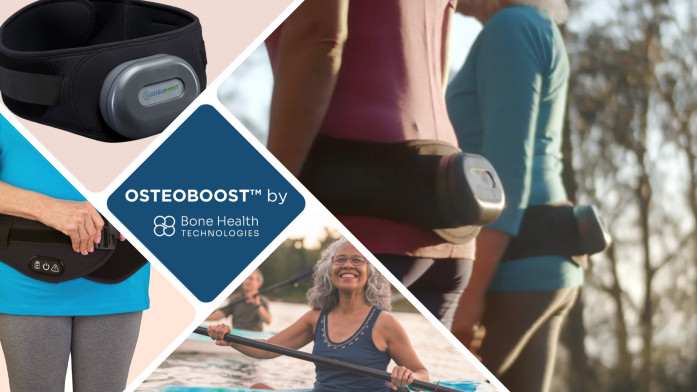
Bone Health Technologies Announces FDA Clearance of OsteoboostTM, the First Prescription Medical Device to Treat Low Bone Density
- Osteoboost is the first and only non-pharmacological prescription treatment to demonstrate reduced loss of bone strength in postmenopausal women
- Represents the first therapeutic mechanism specifically designed and cleared for intervention during the osteopenia stage
REDWOOD CITY, CA / ACCESSWIRE / January 18, 2024 / Bone Health Technologies today announced that the U.S. Food and Drug Administration (FDA) has granted clearance for OsteoboostTM, the first non-pharmacological device-based prescription treatment for postmenopausal women diagnosed with osteopenia (low bone density).
 Osteoboost
Osteoboost Osteoboost is the first FDA-cleared prescription medical device to treat osteopenia.
Osteoboost is a wearable belt device, worn on the hips, that delivers targeted, calibrated vibration to the lumbar spine and hips. Osteoboost is indicated to reduce bone strength and density decline in postmenopausal women and is the first and only solution specifically designed to improve bone health during osteopenia. This breakthrough technology is safe, medication-free, and easy to use at home, making it suitable for a wide variety of patients with bone density loss.
An estimated 52 million Americans have osteopenia, the precursor to osteoporosis, driving an addressable market of over $30 billion in the U.S. and $100 billion globally. Half of all women suffer from fractures during their lifetime, and most of these fractures occur during the osteopenia stage.
"Today's groundbreaking decision represents the first non-pharmacological therapy approved to treat this widespread and serious condition. With Osteoboost, we have a new treatment option - free of serious adverse events - that taps into the body's natural mechanism to stimulate bone growth," said Laura Yecies, CEO of Bone Health Technologies. "Women's health has been underserved for too long, making this a huge step forward for older women who have lacked effective treatment options and are seeking an effective way to protect their bone health."
Osteoboost was reviewed through the FDA's De Novo classification process and received Breakthrough Device Designation. The Osteoboost clearance creates an entirely new class of therapeutics for low bone density outside of pharmacological intervention. Notably, Osteoboost also represents the first therapeutic mechanism specifically designed and cleared for intervention during the osteopenia stage. Until now, patients with osteopenia have lacked effective therapeutic options. Before Osteoboost, the standard of care for osteopenia focused on regular weight-bearing exercise and calcium supplementation - neither of which have been proven to significantly slow the loss of bone density.
"There are millions of American women with low bone density or osteopenia. This is often the precursor to osteoporosis. We have little to offer those women other than calcium and vitamin D supplements," said David B. Karpf, MD, Adjunct Clinical Professor of Endocrinology, Gerontology & Metabolism, Stanford University School of Medicine and attending in the Osteoporosis & Metabolic Bone Disease Clinic. "The field of bone health right now is missing innovative approaches - there are no new agents in clinical trials for osteoporosis and nothing for women who have osteopenia. With the aging of our population, we need new ways to effectively prevent the decline in bone mass and strength that affects all women in the peri-menopause or post-menopausal stage."
Osteoboost was granted clearance based on data from an NIH-funded double-blinded, sham-controlled study conducted at the University of Nebraska Medical Center. The data, which were shared at the 2023 ENDO and ASBR conferences, demonstrate the efficacy of Osteoboost in directly stimulating bone growth and preserving bone mineral density and strength by sending low-frequency vibrations directly to the lumbar spine and hips.
The primary outcome measurement was the change in vertebral strength measured by CT scan. Per Protocol (PP) - subjects (those who used the device a minimum of three times per week) in the Active Treatment group lost, on average, 0.48% bone strength while those in the Sham group lost 2.84%, with a relative difference of 2.36% (P=0.014). Additionally, CT measurement of vertebral bone density was conducted and showed a 1.68% relative benefit for those using the Osteoboost (P=0.008). These results represent a dramatic reduction in the loss of bone strength and density. Zero serious adverse events were reported.
"The well-being and ability of postmenopausal women to maintain an active lifestyle is threatened when loss of estrogen causes rapid loss of bone," said Laura Bilek, Ph.D., Associate Dean for Research and Associate Professor at the University of Nebraska and principal investigator for this study. "Although lifestyle interventions such as exercise and diet are beneficial to bone, the effect is small. The Osteoboost shows promise in slowing the loss of bone density and strength and may fill the treatment gap."
About Bone Health Technologies
Bone Health Technologies (BHT) is a Redwood City-based company that applies science and medical expertise to create better health outcomes for women and men at risk of developing osteoporosis and associated bone fractures. The company's first FDA-approved device, Osteoboost, is poised to become the new standard of care in treating post-menopausal osteopenia. BHT is backed by leading investors, including Esplanade Ventures, Ambit Health Ventures, Good Growth Capital, Portfolia, Astia Angels, and Golden Seeds. For more information about BHT and Osteoboost, including the full Indications for Use, please visit www.bonehealthtech.com.
Contact Information
Colin Sanford
colin@bioscribe.com
1-203-918-4347
Related Files
Osteoboost FDA Clearance - Infographic.pdf
SOURCE: Bone Health Technologies
View the original press release on newswire.com.
Editor Details
-
Company:
- AccessWire
- Website:
